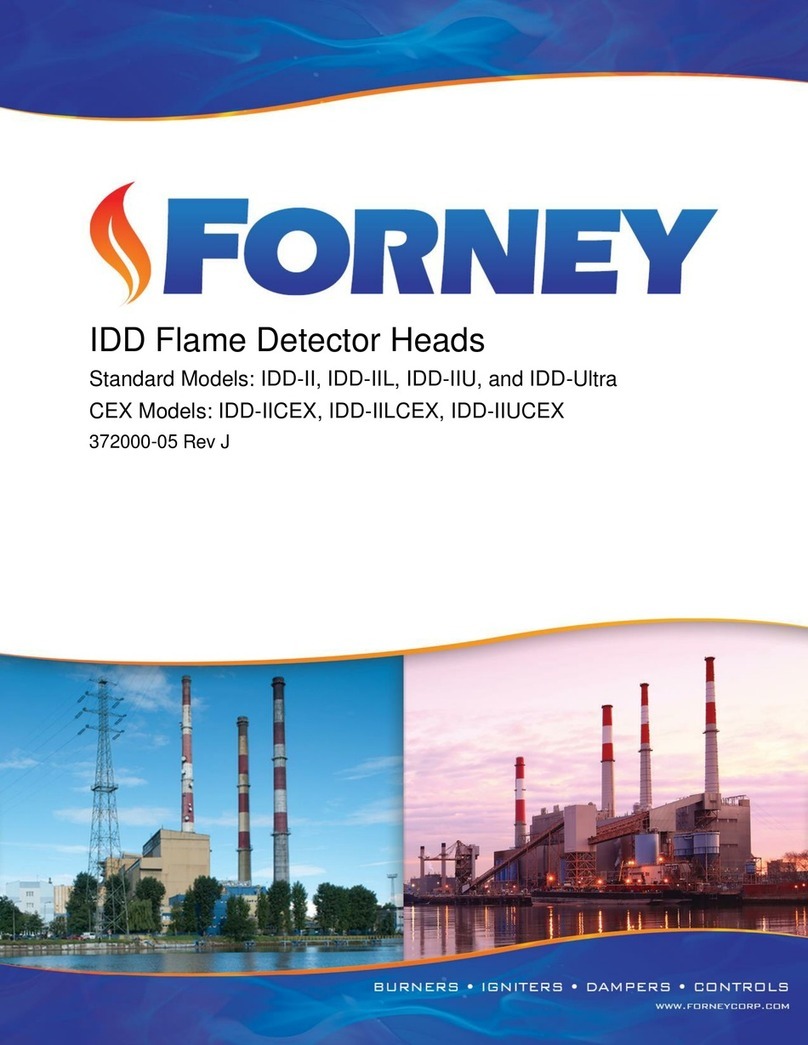
UV-4 Flame Detector
372000-28 Rev J
7
Section 5 Operation
The Forney UV-4 detector normally is sighted on the primary combustion zone of a burner, and light from
the burner flame passes through a sight tube or a fiber-optic light guide to an opening in the base assembly
housing. Because the sensor tube is positioned directly behind this opening, essentially all light enters the
tube. IF the intensity of the UV light is great enough to ionize the gas in the tube, the flame detector head
generates a continuous pulse train.
5.1 Normal Operation
Electronic components in the UV-4 flame detector PCB include a dc-dc voltage converter, RC biasing
network, optocoupler, and single-shot. The external amplifier provides +14 vdc power, which is applied to
all active components on the PCB. The dc-dc voltage converter boosts the input power to produce a large
potential difference between the anode and cathode inside the UV sensor tube. The sensor tube contains a
gas that can be ionized by absorbing energy directly from UV radiation. If the rate of ionization exceeds the
rate of recombination, a surge of current passes through the tube, producing a high-voltage transient. The
tube operates with a nominal 350-vdc bias voltage and requires a threshold flux of UV radiation to start
conducting. Each time the tube enters the conducting state, a capacitor in the anode circuitry discharges
through the cathode circuit, dropping the bias below 350 vdc. This drop in bias voltage causes the tube to
stop conducting almost immediately, and the power supply begins recharging the capacitor in the anode
circuit. Since the RC time constants for the anode and cathode circuits are fixed, the interval between
successive discharges is directly proportional to the magnitude of UV flux incident on the tube.
Each discharge through the sensor tube produces a high-voltage pulse having a duration of no more than a
few microseconds. Since the magnitude of the voltage pulse is far too great for logic circuitry, the
optocoupler performs level conversion and also inverts the signal to produce a low-active trigger pulse. The
leading edge of each trigger pulse then causes the single-shot to generate a digital output pulse having a
fixed pulse width of 500 µs. When considered as a function of time, the frequency of the output signal from
the head is directly proportional to the intensity of UV radiant energy striking the tube.
5.2 Self-Test Operation
The external amplifier normally runs a self-test cycle at regular intervals under program control. At the start
of each self-test cycle, the amplifier enables +15 vdc to energize the shutter solenoid, blocking the light path
mechanically. The amplifier then monitors the input signal from the detector head to verify that a flame-out
condition is detected. If the input signal continues to indicate flame presence for the entire test interval, the
amplifier activates an alarm to indicate test failure.
Section 6 Maintenance
The only maintenance needed by the UV-4 detector head is periodic cleaning of the glass lens (direct-view
configuration only). The appropriate cleaning schedule is determined by the quality and cleanliness of the
cooling-/seal-air source. Forney recommends the use of a non-oily cleaning solution and a soft lint-free cloth
for lens cleaning.





























